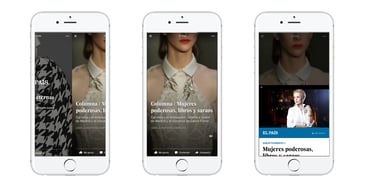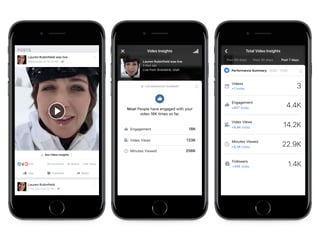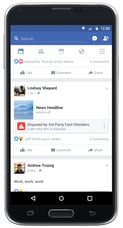In December 2016, Facebook co-founder and CEO Mark Zuckerberg stated that Facebook has evolved from a traditional social media network into a new type of media company -- one that offers a hybrid technology and news platform where content creators and readers publish, share, and talk about what's happening in the world. Facebook has started taking greater responsibility for content shared on the platform, and over the past several months, it has rolled out many new features that are highly relevant for content creators and social media managers to learn more about. Facebook wants to work with news organizations to help make new content formats, such as Facebook Live, 360 video, and Instant Articles, work better for publishers. Here's how disputed stories and warnings will appear in the News Feed: The Facebook Journalism Project was just recently announced, and we'll report back on any new publishing formats or changes as they evolve. Video insights in particular will be highly useful as it becomes easier for marketers to create more video content. “Mid-roll video advertisements will incentivize marketers to create video content that doesn’t just chase vanity metrics (such as views) but also focuses on retention," Emanuele notes. Most recently, Messenger started testing a new "Add Contact" feature that allows users to connect with people on the app without becoming friends on Facebook. The new features Messenger is unrolling make it more independent from Facebook itself and make it easier for new users to start communicating on the platform. Instead, users will be able to save meaningful content that they want to read later, meaning your content doesn’t need to be created for quick, immediate consumption.” March 2016 Facebook determined that users spent 3X more time watching Facebook Live videos that regular videos, so they announced that they would begin ranking them higher in the News Feed in response to users' preferences. Users can also get notified when Pages they follow start recording live, so if live video isn't part of marketers' strategies already, it's a great way to earn more meaningful engagement on the platform.

In December 2016, Facebook co-founder and CEO Mark Zuckerberg stated that Facebook has evolved from a traditional social media network into a new type of media company — one that offers a hybrid technology and news platform where content creators and readers publish, share, and talk about what’s happening in the world.
The announcement marks a shift from Zuckerberg’s previous statements that Facebook would not become a media company, and the significance is meaningful. Facebook has started taking greater responsibility for content shared on the platform, and over the past several months, it has rolled out many new features that are highly relevant for content creators and social media managers to learn more about.
We know it’s challenging to keep up with all of the breaking technology news out there, so we’ve compiled a list of recent changes and new features to Facebook for marketers to plan for.
7 New Facebook Features You May Have Missed
January 2017
Facebook Journalism Project
Facebook cemented its role as a new kind of media company with the announcement of the Facebook Journalism Project, its initiative to collaborate more closely with journalists and content creators publishing on the platform.
According to Facebook Director of Product Fidji Simo, here’s how the Facebook Journalism Project will work:
1) Facebook will work with news outlets to develop new ways of creating and distributing content on the platform.
Facebook wants to work with news organizations to help make new content formats, such as Facebook Live, 360 video, and Instant Articles, work better for publishers. Simo also mentions an interest in creating new products that better suit readers who are getting news from the platform — approximately 66% of Facebook users. One feature Facebook is launching under this initiative is the ability for publishers to share multiple Instant Articles in a single post, like a mini digital newspaper. Here’s what it will look like:

2) Facebook will provide partner journalists more tools for analyzing content performance.
Facebook Page administrators can now designate contributors so different journalists can post content on the platform, similar to a traditional newsroom. Additionally, the Facebook Journalism Project will provide more video analytics insights for publishers on the platform. Now, video content creators will be able to see more meaningful metrics for how live and regular videos perform on Facebook, such as total minutes viewed and total engagements.

Source: Facebook
3) Facebook will continue its initiative to fight fake news and promote greater news literacy.
After news broke that fake news stories outperformed real news stories on the platform during the U.S. election, Facebook announced new initiatives to make it harder to publish and easier to identify hoax news. The initiative include working with third-party fact checkers, disrupting financial incentives for hoaxers to post these stories, and making it easy for Facebook users to dispute content that they believe is fake. This system will make the content appear lower in the News Feed, produce a warning to readers that the content is under review, and the content can’t be promoted or turned into an ad. Here’s how disputed stories and warnings will appear in the News Feed:


The Facebook Journalism Project was just recently announced, and we’ll report back on any new publishing formats or changes as they evolve. For now, content creators should experiment with new capabilities and analytics as they become available in order to better measure their social media strategy’s efficacy. Video insights in particular will be highly useful as it becomes easier for marketers to create more video content.
Facebook Live Broadcasts From Computers
Facebook Live, which lets users broadcast live video from their mobile phones directly onto the News Feed, launched in May 2016. It quickly experienced rapid growth, and Facebook recently announced that Pages will now be able to broadcast live video from computers in addition to mobile phones.
This update will make it easier for users to go live, which has its pros and cons. Filming from a laptop or desktop computer keeps the camera steadier than holding a mobile phone, which improves video…
COMMENTS